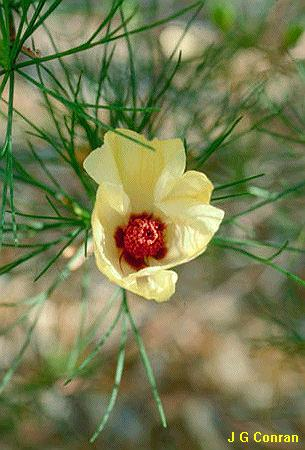General Description:
Alyogyne is a genus of 5 species, all occurring naturally only in Australia. The genus is closely related to the widely cultivated Hibiscus which differs in having a divided style (the female part of the flower). All species of Alyogene (except for A.cravenii) were previously included in Hibiscus. Alyogyne is also related to the well-known Sturt’s Desert Rose, Gossypium sturtianum. Alyogyne hakeifolia has also been known as Hibiscus hakeifolius, Cienfuegosia hakeifolia, Fugosia hakeifolia and as Alyogyne lilacina. Plants were grown in England in the early half of the 19th century.
A.hakeifolia is a medium, much-branched upright shrub reaching about 3 metres in height. The leaves are dark green, glabrous, comprised of very narrow linear segments 50-100 mm in length and 1-2mm wide. The individual lobes make the foliage ‘needle-like’. The plant produces an abundance of blooms each season. There are mauve, yellow and pink forms. Like its relative, Hibiscus, the individual flowers last only 1-2 days but new flowers continue to open over a long period, generally from November until March. The blooms are 5-6 cm long, tubular in shape, not opening widely and they usually have a dark red central spot. The capsule is 1.8-2 cm x 1.2 cm and is 5-celled.
As A.hakeifolia is a desert plant, it is well suited to a warm, dry climate. It is intolerant of bad drainage but is adaptable and sufficiently hardy in cool moist climates such as south-eastern Australia. It is less hardy than Alyogyne huegelii in climates such as the subtropics with wet summers. A well-drained sunny spot is ideal although plants will grow in semi-shade. Plants perform best when they receive sunlight for most of the day and have some wind protection as large plants are subject to wind damage. The plant may develop into a well-shaped shrub without any need for pruning but it can be pruned to improve the shape if desired. A.hakeifolia tolerates mild frosts but some protection may be required from heavier frosts.
Propagation from seed is relatively easy and no special pretreatment is needed. Cuttings also strike readily.

Photo: Geoff Keena

Yellow form of Alyogyne hakeifolia
Photo: John Conran
 Australian Native Plants Society (Australia)
Australian Native Plants Society (Australia)